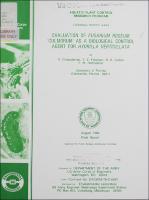Please use this identifier to cite or link to this item:
https://hdl.handle.net/11681/6411| Title: | Evaluation of fusarium roseum culmorum as a biological control agent for hydrilla verticillata |
| Authors: | Charudattan, R. Freeman, T. E. (Thomas Edward), 1930- Cullen, R. E. Hofmeister, F. M. |
| Keywords: | Aquatic plant control Biological control Biocontrol Hydrilla verticillata Pathogens Fungi Fungal pathogens Aquatic Plant Control Research Program (U.S.) |
| Publisher: | U.S. Army Engineer Waterways Experiment Station |
| Series/Report no.: | Technical Report (Aquatic Plant Control Research Program (U.S.)) ; no.Technical Report A-84-5 |
| Abstract: | An isolate of Fusarium roseum 'Culmorum' was isolated in 1974 from diseased Stratiotes aloides (Hydrocharitaceae) plants found near Wageningen, The Netherlands. In laboratory tests conducted in Gainesville, it was found to be pathogenic to a relative of s. aloides, Hydrilla verticillata, one of the most important aquatic plants in Florida. Hydrilla plants grown in different kinds of sterile water in containers ranging from 50-ml tubes to 20-l aquarium tanks were killed following addition of macroconidial suspensions of this isolate and incubation for several weeks. A minimum of 25,000 conidia/ml of treated water were required to kill hydrilla. Following inoculation, shoots turned chlorotic and discolored in 2 weeks, and disintegrated completely in 3 weeks. Histological evidence of infection and the consistent reisolation of this fungus from dying shoots confirmed its pathogenicity. Five other fusaria, including three Florida isolates from hydrilla, did not cause any damage on this host, even at inoculum levels of 250,000 conidia/ ml of treated water. However, an isolate of F. roseum 'Graminearum,' a weak foliar pathogen of Eichhornia crassipes, was lethal to hydrilla at a 60,000 conidia/ml level in the laboratory, but not in an outdoor test, and appeared to be less virulent than the Dutch Culmorum isolate. The host range of the Dutch Culmorum isolate was tested on 80 plant species including crop cultivars and nontarget aquatic plants. Seed infestation and/or seedling inoculation methods were used. Results indicated that the fungus infected some nontarget hosts, but was not a significant primary pathogen of any of the terrestrial hosts tested. It was lethal to certain aquatic plants, which also may be controlled by this isolate. The fungus survived in water or moist soil for at least 9 weeks, but the number of propagules in water declined to a low level during this period. The fungus was harmless to mosquitofish in an acute toxicity bioassay. A fungicide capable of controlling this fungus was identified. Based on these results, it was considered desirable to test the fungus on hydrilla in a large-scale study outside the quarantine laboratory. Accordingly, the test was conducted under semioutdoor conditions in a series of large-scale pilot tests using 3.04-m-diam plastic pools containing hydrilla. Although the fungus-treated hydrilla was consistently more damaged than the nontreated controls, a practical level of biocontrol was not achieved. Therefore, the biocontrol efficacy of the Dutch isolate of F. roseum 'Culmorum' and the prospects for using it as a microbial herbicide are not considered good. Further basic studies are needed to establish the mode of action that underlies the lethal effects of this fungus on hydrilla in s mall-scale tests. An understanding of the mode of action may explain the lack of efficacy of the fungus in the large-scale tests and may help overcome this problem. |
| Description: | Technical Report |
| Gov't Doc #: | Technical Report A-84-5 |
| Rights: | Approved for public release; distribution is unlimited |
| URI: | http://hdl.handle.net/11681/6411 |
| Appears in Collections: | Technical Report |
Files in This Item:
| File | Description | Size | Format | |
|---|---|---|---|---|
| TR-A-84-5.pdf | Technical Report A-84-5 | 14.42 MB | Adobe PDF |  View/Open |